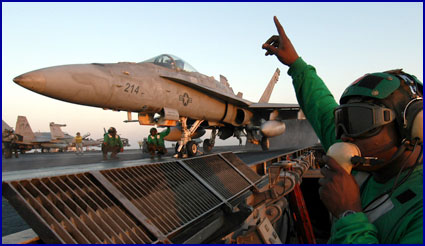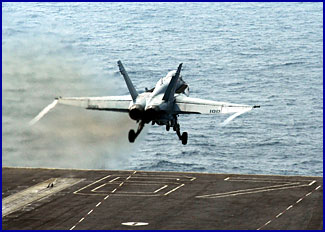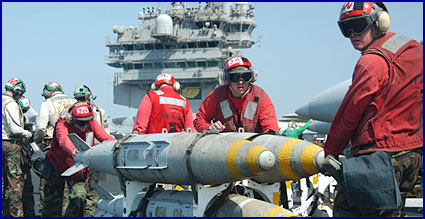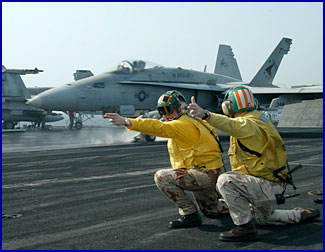Naval Aviation Safety and Its Application to Medicine
March / April 2006
Naval Aviation Safety and Its Application to Medicine
![]()
 |
| U.S. Navy photo by Photographer’s Mate Third Class (AW/SW) Joshua Karsten. |
Around 400 B.C., Hippocrates penned his famous oath binding himself to an unwavering commitment to his patients’ well-being. Throughout history and today, medical institutions have adopted the Oath of Hippocrates as proclamation of their dedication to compassionate and skilled patient care. Physicians aspire to uphold the oath’s declarations, such as, “I will do no harm or injustice” (National Library of Medicine, n.d.) and assume what is traditionally understood as a “singular battle with disease” (Brennan, 2002, p. 973) on the part of the physician. This commitment, “one of selfless attending on a single patient, no matter what the hour or other calls on the physician’s time… reverberates throughout the medical profession” (Brennan, 2002, p. 973).
In a practical sense, preservation of patient safety is at the forefront of this conviction, but patient safety programs have not yet been fully implemented, and the high level of patient safety to which physicians aspire remains elusive. Consequently, patient safety has developed into a major concern among the general public and state and federal policymakers (Markowitz, 2001). The Institute of Medicine’s (IOM) report To Err Is Human: Building a Safer Health System“shocked the sensibilities” (Markowitz, 2001) of many in the United States with the estimate that 44,000 to 98,000 deaths occur per year as a result of medical errors (IOM, 2000, p. 1). Without universal and highly visible systems established to minimize errors, the healthcare system falls short of its own aspirations of superior patient safety.
U.S. Naval aviation certainly differs from the medical field in many respects, but the Hippocratic concepts of self-sacrificial service and dedication to quality and safety are also of supreme importance to Navy personnel. Though both high-risk fields champion these convictions, the Navy has been much more successful in improving systems and thus achieving a high level of safety. While current medical practice leads to the publication of reports such as To Err Is Human, Naval aviation has drastically decreasedits incidence of Class A mishaps (an accident involving a fatality, a major injury, or destruction of the aircraft) over the past 50 years to a current rate of 11 per 183,000 flight hours (Naval Safety Center Status Report, 2005). As a member of the concerned medical community working to decrease the number of medical mishaps, I have investigated U.S. Naval aviation precautions and ways in which such practices can be applied to medicine.
 |
|
| U.S. Navy photo by Photographer’s Mate Airman (AW) Nicholas Garratt. |
Aviation and medicine have several similar characteristics: both are fast-paced; decisions are made in split seconds, with consequences involving life or death; both rely heavily on training, regulations, the most recent technological advances, and human effort and skill; and human error accounts for the vast majority of mishaps (Wiegmann & Shappell, 1999; Halamek, et al., 2000; Shappell, et al., 1998).
The Navy has drastically reduced the incidence of mishaps through system-wide safety programs, standardization of procedures, and aircraft design improvements (Wiegmann & Shappell, 1999). American healthcare lacks many elements of the organizational commitment and structure needed to achieve safety in healthcare delivery. Our present healthcare system focuses on individual events and people, rather than taking the more global approach of understanding the root causes of human error and their impact on patient safety. Safety is often pursued as a reactive, retrospective measure and thus, to a degree, remains elusive (ASHRM, 2004).
With such issues in mind, I visited the Naval Safety Center and was privileged to study Naval aviation safety as a guest of Captain Dennis E. FitzPatrick on the aircraft carrier USS John F. Kennedy during 9 days of sea qualifications and cyclic operations. In this article, I recommend ways in which Naval aviation safety concepts may be applied to medical practice.
The Center for Naval Aviation Safety
At the heart of Naval aviation safety is the Naval Safety Center (NSC). This center was established in 1951 to collect, evaluate, and publish information about aviation safety and today provides a network of safety training, education, and mishap prevention programs for the Navy and Marine Corps (Naval Safety Center Fact Sheet, 2005). In 1953 alone, there were 2,266 major aircraft accidents involving 5% of the 14,051 operating Naval aircraft and claiming the lives of 423 Naval aviation personnel.
These events incited the Navy’s steadfast commitment to Naval aviation safety. Progress reflects numerous factors, including technological advances in aircraft safety and design, as well as the growth of “human factors” research and development (Wiegmann & Shappell, 1999). In 2004, only 30 Class A mishaps occurred. The NSC has led a cultural change in Naval aviation through worldwide mishap investigations, safety surveys and seminars, and oversight reviews.
In the field of medicine, an analogous “national patient safety center” with the mission of promoting healthcare safety does not exist. Various organizations, such as the Institute of Medicine, have proposed formation of such an entity, but to date, none have successfully emerged (IOM, 2000). The Naval Safety Center provides a model for nationwide safety standards in medicine.
Operational Risk Management (ORM)
The Navy developed Operation Risk Management (ORM) in 1991 to improve safety in the development of new weapons, space vehicles, aircraft, and nuclear power, and thus minimize losses of all types. ORM recognizes that risk is inherent in Naval operations, and simply aims to minimize risk. The program is a process in which personnel identify and control hazards to maximize mission success. Formal processes that are proactive, systematic, and methodical replace traditional, reactive measures based on intuition, anecdotal experience, and compliance-based programs, challenging all involved in operations to participate in the process of risk reduction. ORM is made up of three basic elements: Principles, Steps, and Levels. Principles focus on risk assessment; Steps involve hazard analysis, implementation of various controls, and command structure; and Levels describe time-related factors regarding risk management implementation (Naval Safety Center ORM, 2005).
 |
| U.S. Navy photo by Photographer’s Mate Airman Tommy Gilligan. |
Though not formalized, the concepts of ORM are intuitive to physicians and can easily be applied to medical situations. Healthcare presently lacks ORM’s formal framework for risk assessment and prevention, and would benefit from adopting the principles of ORM in all levels of training and practice.
Crew Resource Management
Crew Resource Management (CRM) is a program designed to enhance crew communication in military and commercial aviation through teamwork and simulation training. In the Navy, CRM is designated as Aircrew Coordination Training (ACT). ACT was initiated in 1979 with NASA’s investigation of the role of human factors in airline crashes (Cooper, White, & Lauber, 1980) and is now an accepted program of study and training in the role of human factors in the high stress, high-risk environment of aviation (Pizzi, Goldfarb, & Nash, 2001). The Navy understands that human error is responsible for more than 50% of aviation accidents (Wiegmann & Shappell, 1999). To reduce such incidents, ACT teaches aircrew about the limits of human performance, such as the role of fatigue, work overload, cognitive errors, and communication failures (Pizzi, Goldfarb, & Nash 2001, Chap. 44).
Currently, medicine is in the earliest stages of incorporating the principles of ACT/CRM in its training and teaching. Historically, medicine has stressed technical competency, but has done very little to address behavioral teamwork and its coordination with technical expertise (Halamek, et al., 2000). Recently, there have been several attempts to implement these concepts in medicine, which are effectively summarized by Pizzi, Goldfarb, and Nash (2001, chap. 44).
Landing Safety Officers and Grading of Competency
Landing Safety Officers on aircraft carriers are typically senior lieutenants who stand several feet from the wingtips of aircraft landing on a carrier. Their job is to grade each landing performed by pilots of every rank, and these grades are then posted and available to be viewed by other aviators. This form of continuous peer review strongly encourages pursuit of excellence.
The concept of grading physicians is still in its earliest stages, but has been gathering momentum over the last several years, especially with rising healthcare costs. Employer groups are currently spending significant percentages of revenue on healthcare, and are demanding better value for their healthcare dollar, as well as resultant “quality” (Baker, 2003). Similarly, consumers desire to identify high-quality practitioners but have few available tools to guide this process. Medicine must continue to move in this direction.
Safety Officers and a Culture of Safety
In Naval aviation, safety officers (SOs) are central to the maintenance of the culture of safety. Senior SOs occupy budgeted positions with excellent visibility, clearly defined roles, and ready access to the Commanding Officer.
While hospitals have a variety of positions related to patient safety, the role of the Patient Safety Officer (PSO) has only recently been emphasized. Unfortunately, the roles, responsibilities, training, competencies, and organizational fit of a PSO remain poorly defined and without standardization (American Society for Healthcare Risk Management, 2004). Yet, PSO functions are vital in ensuring compliance with JCAHO’s National Patient Safety Goals and other safety initiatives.
Connectivity
An impressive feature of the aircraft carrier is the coordination of all activities on the deck by the Air Boss and Mini Boss through use of state-of-the-art communication. The Air Boss, who is responsible for the successful, safe operation of the flight deck, must communicate in real-time with the pilots, ground crew, shooters, catapult, arresting gear crew, and landing safety officers, as well as with the captain of the ship. This communication facilitates “connectivity,” a principle to which the Navy has long been committed.
Medicine lags behind the Navy in its sense of connectivity. However, recent attempts to establish connectivity through the use of electronic medical records (EMRs) have already dramatically increased the efficiency and the safety of healthcare delivery. EMRs of this type allow all healthcare providers involved in a patient’s care to legitimately and securely view a patient’s record while delivering care. This type of information congruency facilitates coordination and integration of care across multiple disciplines, improves the monitoring and management of chronic health conditions, and allows for the assimilation of “best practice” and practice guidelines in the delivery of care. Medication errors are significantly reduced, and illegible handwriting is no longer an issue. Real-time provision of a patient’s complete record better facilitates healthcare safety.
Color Coding of Job Descriptions
Color-coding of all individuals involved in flight deck operations is another effective technique of Naval aviation safety. White float-coats are worn by safety personnel, purple by fuel personnel, red by ordinance/fire-fighting personnel, and yellow by shooters. The ability to immediately identify roles and responsibilities of personnel is a critical safety feature on the flight deck.
Implementation of this simple scheme remains anecdotal in the field of medicine. However, hectic emergency departments might benefit from ready identification of phlebotomists, respiratory therapists, R.N.s, L.P.N.s, M.A.s, and radiation technicians by color-coded scrubs. This would provide ready identification of specific job types, and would also be appreciated by patients given instruction in staff identification.
Checklists and the Use of Guidelines
Pilots use checklists in the operation of military jet aircraft to provide a format to standardize behavior, promote safety, and prevent unnecessary mishaps. Naval aviators study and use checklists kept in close proximity, often strapped to his or her leg during flight operations.
An immense body of literature supports the generic use of checklists, protocols, and the standardization and simplification of practices designed to compensate for human error (Leape, Berwick, & Bates, 2002). However, these safety measures are not often implemented in the field of medicine. Standardization and incorporation of medical practice guidelines into the electronic medical record will promote patient safety.
Command Structure and Leadership
The command structure of a carrier is a critical element in the maintenance of the culture of safety. While a ship has several captains, there is only one Commanding Officer, upon whom all responsibility ultimately rests. On the aircraft carrier, clean lines of authority promote accountability, responsiveness, ownership, and subsequently, safety.
Leadership development among physicians is a quality that is given little attention in healthcare. However, both in health systems and private practices, physicians are increasingly being called upon to provide leadership (Becker & Chassin, 2001). Though this is not yet a focal point in the medical community, the American Board of Internal Medicine (ABIM) Foundation and the Agency for Healthcare Research and Quality (AHRQ) have recently invested in identifying and training physician leaders and champions (Goode et al., 2002, p. 950). These groups rightly acknowledge that physician leadership will be required to provide the vision, passion, and clear voice needed to bring all factions into common ground to promote safety.
Summary
Though physicians are committed to ministering to their patients’ needs and keeping them from “harm and injustice,” America’s healthcare system has not fully succeeded in providing patients with superior safety. Naval aviation has implemented several programs and various methods that have strikingly reduced the incidence of mishap. Application of these techniques would greatly increase quality and safety in the medical field. Medicine can model safety systems after Navy institutions, programs, and principles such as the Navy’s centralized Naval Safety Center; Operational Risk Management and Crew Resource Management programs; ongoing pilot-evaluation system; designated safety officers; state-of-the-art connectivity; use of checklists and guidelines; and efficient command structure and well-qualified leadership.
 |
|
| U.S. Navy photo by Photographer’s Mate Airman (AW) Tommy Gilligan. |
The few areas of medicine that have begun to adopt some of these safety techniques have uniformly shown positive results and provide excellent models for healthcare. As in Naval aviation, no single change will have a dramatic impact on standardizing safety in medicine; rather, a wide array of changes applied over a period of time will eventually improve healthcare safety (Leape, Berwick, & Bates, 2002).
The IOM report regarding the number of patient deaths caused by medical errors concludes that, to improve patient safety, “the external environment [must] create sufficient pressure to make errors so costly in terms of ability to conduct business in the marketplace, market share, and reputation that the organization must take action” (IOM, p. 21). Errors in Naval aviation are vividly “costly”; often, the penalty is death. And yet, Naval aviation was not able to achieve the current high level of safety until a multifaceted, systematic approach to safety was implemented. Upon adoption of this approach, the Navy successfully reduced the mishap rate by greater than 50% (Naval Safety Center Status Report, 2005). Recent reports regarding the number of patient deaths should urge physicians and other healthcare workers to take immediate action, but no amount of “external” penalty for inadequate patient safety will change the rate of medical errors. Better patient safety will arise from comprehensive systems and formalized procedures designed to promote safety at every level of patient care.
Physicians knowingly serve their patients in a field characterized by “intense time pressures, unpredictable responses, complex communication patterns, involving multiple personnel” (Halamek, et al., 2000, p. 4), and risk is understandably high. Such characteristics describe the JFK as well, and its crew has achieved superior safety in an extremely hazardous environment. By creation of systems modeled after those on the USS John F. Kennedy, healthcare can achieve the same.
Acknowledgment
I would like to thank Captain Dennis FitzPatrick and his crew on the USS John F. Kennedy for their hospitality, service, and commitment to excellence. I would also like to thank my daughter, Elizabeth Harmon, for her assistance with the manuscript.
Kirk Harmon is the medical director of Franciscan Occupational Health, a clinical instructor affiliated with the University of Washington, a Fellow in the American College of Occupational and Environmental Medicine, vice president of the Northwest Association of Occupational and Environmental Medicine, and a former F-4 flight surgeon. He practices occupational medicine in Tacoma, Washington, and may be contacted at kirk.harmon@yahoo.com.
References
American Society for Healthcare Risk Management (ASHRM). (2004, June). The growing role of the patient safety officer: Implications for risk managers.[Monograph]. 1-13.
Baker, G. (2003). Pay for performance incentive programs in healthcare: Market dynamics and business process.Sponsored by ViPS, inc. in partnership with med-vantage. [Research report]. 1-18.
Becher, E. C., & Chassin, M. R. (2001). Improving the quality of health care: Who will lead? Health Affairs,20(5), 164-179.
Brennan, T. A. (2002). Physicians’ professional responsibility to improve the quality of care. Academic Medicine,77, 973-980.
Cooper, G. E., White, M. D., Lauber, J. K.. (1980). Resource management on the flight deck: Proceedings of a NASA/Industry Workshop.Moffett Field, CA: NASA-Ames Research Center. NASA Conference Publication No.CP-2120.
Goode, L., Clancy, C., Kimball, H., Meyer, G., & Eisenberg, J. (2002, October). When is “Good Enough”? The role and responsibility of physicians to improve patient safety. Academic Medicine,77(10), 947-952.
Halamek, L. P., Kaegi, K. M., Gaba, D. M., Sowb, Y. A., Smith, B. C., Smith B. E., & Howard, S. K. (2000, October). Time for a new paradigm in pediatric medical education: Teaching neonatal resuscitation in a simulated delivery room environment. [Electronic version] Pediatrics, 106(4). Accessed March 30, 2005, at www.pediatrics.org/cgi/content/full/106/4/e45
Institute of Medicine (IOM). (2000). To err is human: Building a safer health system. L. T. Kohn, J. M. Corrigan, & M. S. Donaldson (Eds.). Washington, DC: National Academy Press.
Joint Commission for the Accreditation of Healthcare Organizations. (2005). 2005 National Patient Safety Goals. See www.jcaho.org/accredited+organizations/patient+safety/npsg.htm
Leape, L. L., Berwick, D. M., & Bates, D. W. (2002). What practices will most improve safety?[Electronic version]. Journal of the American Medical Association, 288(4):501-507.
Markowitz, A. J. (Ed.) 2001. Making health care safer: A critical analysis of patient safety practices [Summary]. Agency for Healthcare Research and Quality (AHRQ) [Online]. Evidence Report/Technology Assessment, No. 43. Available at www.ahrq.gov/clinic/ptsafety/summrpt.htm
National Library of Medicine. (n.d.). Greek medicine, the Hippocratic oath [Online].See: www.nlm.nih.gov/hmd/greek/greek_oath.html
Naval Safety Center. (2005, May 16). Naval Safety Center Bi-Weekly Status Report to Flag and General Officers.
Naval Safety Center. (2005). Naval Safety Center Fiscal Year 2005 Fact Sheet.
Naval Safety Center (2005). Operational Risk Management (ORM). [Online]. Available at: www.safetycenter.navy.mil/orm/generalorm/introduction/default.htm
Pizzi, L., Goldfarb, N. I., & Nash, D. B. (2001). Crew resource management and its applications in medicine (Chapter 44). In A. J. Markowitz (Ed). Making health care safer: A critical analysis of patient safety practices. Agency for Healthcare Research and Quality [Online]. Evidence Report/Technology Assessment, No. 43. Available at www.ahrq.gov/clinic/ptsafety/chap44.htm
Shappell, S., Squire, H., Abad, G., & Wiegmann, D. (1998). An analysis of U.S. Navy and Marine Corps mishaps using the failure analysis classification system: Implications for prevention. Aviation Space Environmental Medicine,69, 257.
Wiegmann, D. A., & Shappell, S. A. (1999). Human error and crew resource management failures in naval aviation mishaps: A review of U.S. Naval Safety Center data, 1990-1996. Aviation Space Environmental Medicine, 70(12), 1147-51.
